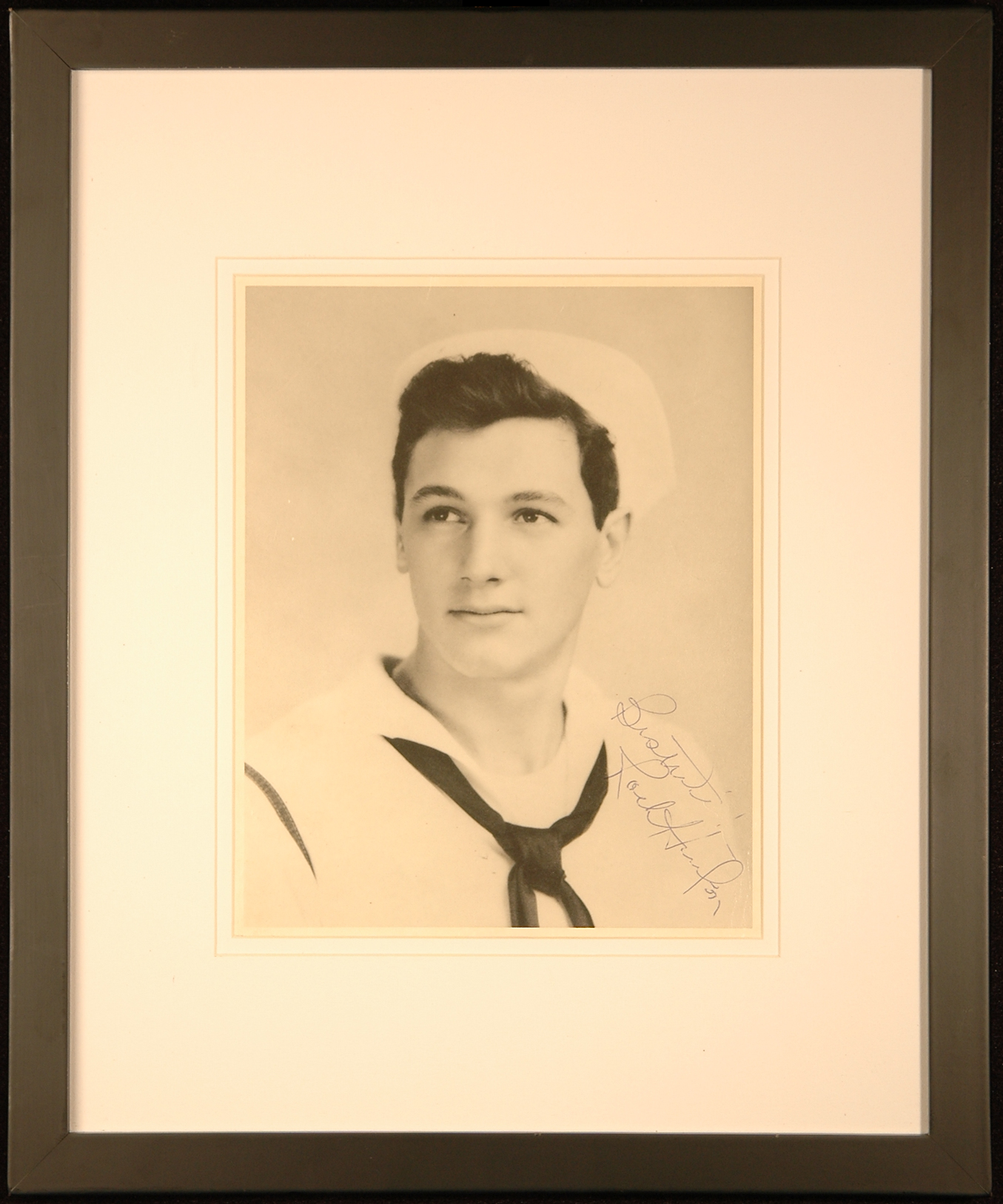Rock Hudson
Rock Hudson
Rock Hudson Navy Enlistment Photograph Signed - 1944
An extremely scarce and handsome matte finish vintage photograph of Hudson when he joined the Navy at just 18 years old, signed “Best wishes, Rock Hudson”. Some ink skipping mostly in sentiment.
On the reverse side of the photo is a handwritten date and time—October 9, 1959 – 1:30 am. That date does match a specific event in Hudson’s life: it was the evening CBS aired the premiere episode of a short-lived series called “The Big Party,” starring Rock Hudson in his penthouse apartment with a “cast” of notable stars of the era drinking and carrying on (more descriptive detail here):
The Big Party (Premiere)
08 Oct 1959 CBS Thurs
Rock Hudson’s penthouse party turns out to be a mighty pleasant affair.
It’s all thanks to Rock’s graciousness
screen legend Tallulah Bankhead
entertainer Sammy Davis Jr. who performs “Fascinatin’ Rhythm”.
actress Esther Williams
singer-actress Lisa Kirk
humorist Mort Sahl
Matt Dennis
Barbara Britton
and musician Carlos Montoya who performs “Malaga” on his flamenco guitar
ROCK HUDSON (1925-1985) was an American film and television actor, recognized as a romantic leading man during the 1960s and 1970s. He was voted Star of the Year, Favorite Leading Man, and similar titles by numerous movie magazines and was unquestionably one of the most popular and well-known movie stars of the time. He completed nearly 70 motion pictures and starred in several television productions during a career that spanned over four decades. Hudson was also one of the first major Hollywood celebrities to die from an AIDS related illness.
Hudson was born Roy Harold Scherer, Jr., in Winnetka, Illinois, the son of Katherine Wood, a telephone operator, and Roy Harold Scherer, Sr., an auto mechanic who abandoned the family during the depths of the Great Depression. His mother remarried and his stepfather Wallace “Wally” Fitzgerald adopted him, changing his last name to Fitzgerald. Hudson’s years at New Trier High School were unremarkable. He sang in the school’s glee club and was remembered as a shy boy who delivered newspapers, ran errands and worked as a golf caddy.
After graduating from high school, he served in the Philippines as an aircraft mechanic for the United States Navy during World War II. In 1946, Hudson moved to the Los Angeles area to pursue an acting career and applied to the University of Southern California’s dramatics program, but he was rejected owing to poor grades. Hudson worked for a time as a truck driver, longing to be an actor but with no success in breaking into the movies. A fortunate meeting with Hollywood talent scout Henry Willson in 1948 got Hudson his start in the business.
Hudson made his debut with a small part in the 1948 Warner Bros.’ Fighter Squadron. Hudson needed no less than 38 takes before successfully delivering his only line in the film.
He was further coached in acting, singing, dancing, fencing and horseback riding, and he began to feature in film magazines where he was promoted, possibly on the basis of his good looks. Success and recognition came in 1954 with Magnificent Obsession in which Hudson plays a bad boy who is redeemed opposite the popular star Jane Wyman. The film received rave reviews, with Modern Screen Magazine citing Hudson as the most popular actor of the year. Hudson’s popularity soared in George Stevens’s Giant, based on Edna Ferber’s novel and co-starring Elizabeth Taylor and James Dean. As a result of their powerful performances, both Hudson and Dean were nominated for Oscars in the Best Actor category.
Following Richard Brooks’s notable Something of Value in 1957 and a moving performance in Charles Vidor’s A Farewell to Arms, based on Ernest Hemingway’s novel, Hudson sailed through the 1960s on a wave of romantic comedies. He portrayed humorous characters in Pillow Talk, the first of several profitable co-starring performances with Doris Day. This was followed by Come September, Send Me No Flowers, Man’s Favorite Sport?, The Spiral Road, and Strange Bedfellows. He worked outside his usual range on the science-fiction thriller Seconds (1966). The film flopped badly at the time but it later gained cult status, and his performance is often regarded as one of his best.
Hudson had been diagnosed with HIV on June 5, 1984, but when the signs of illness became apparent, his publicity staff and doctors told the public he had inoperable liver cancer. It was not until July 25, 1985, while in Paris for treatment, that Hudson issued a press release announcing that he was dying of AIDS. In a later press release, Hudson speculated he might have contracted HIV through transfused blood from an infected donor during the multiple blood transfusions he received as part of his heart bypass procedure. Hudson flew back to Los Angeles on July 31, where he was so physically weak he was taken off by stretcher from an Air France Boeing 747, which he chartered and was the sole passenger along with his medical attendants. He was flown by helicopter to Cedars Sinai Hospital, where he spent nearly a month undergoing further treatment. When the doctors told him there was no hope of saving his life, since the disease had progressed into the advanced stages, Hudson returned to his house, “The Castle,” in Beverly Hills, where he remained in seclusion until his death on October 2 at 08:37 PST. Morgan Fairchild said “Rock Hudson’s death gave AIDS a face”.
All Vintage Memorabilia autographs are unconditionally guaranteed to be genuine. This guarantee applies to refund of the purchase price, and is without time limit to the original purchaser. A written and signed Guarantee to that effect accompanies each item we sell.

